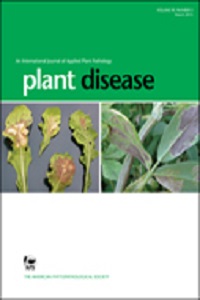First Report of a 16SrIII Phytoplasma Associated with Frogskin Disease in Cassava (Manihot esculenta) in Paraguay
Cassava is a staple food for about 800 million people worldwide. It is produced mainly by smallholder farmers. In July 2013, disease symptoms were observed on the crop, including longitudinal lip-like fissures on roots, and a thick cork-like appearance on root peel. The diseased cassava contained very low starch content. No symptoms were observed on leaves or stems. In Paraguay, the frogskin disease has been detected in the Central Department. Recently, typical symptoms were also observed in the San Pedro Department (Latitude: 23.84564°S, Longitude: 56.58689°W). The 16SrIII-L phytoplasma has been associated with the disease in Colombia (Álvarez et al. 2009). A total of 59 symptomatic roots and 10 asymptomatic samples were collected from the San Pedro Department and total DNA was extracted, using Dellaporta’s protocol (Dellaporta et al. 1983). To detect the 16SrIII phytoplasma, direct PCR was conducted using PCR primers P1/Tint (Smart et al. 1996). The amplified products were used in nested PCR with primers R16F2n/R16R2 (Gundersen and Lee, 1996), followed by specific primers R16(III)F2/R16(III)R1 (Lee et al. 1994). Symptomatic samples produced amplicons of about 800 bp, the same amplicon size as reported by Álvarez (2009). Nested PCR products, amplified with P1/Tint and followed by R16F2n/R16R2, were sequenced and deposited in GenBank (Accession Nos. KF701485, KF701497, and KF701498). A BLAST search showed 99% nucleotide sequence identity with the 16SrIII-L CFSD phytoplasma (EU346761 and AY737647), described by Alvarez et al. 2009. A real-time PCR assay using a TaqMan probe was used as complementary confirmation method. The amplification of the rp (ribosomal protein) gene was performed with primers rpIII-PF/rpIII-PR and TaqMan probe rpIII-p. By real time PCR, a phytoplasma 16SrIII was detected on symptomatic cassava roots samples. No phytoplasma was detected in asymptomatic cassava roots. To our knowledge, this is the first report of a phytoplasma associated with cassava frogskin disease in Paraguay. Symptoms were observed in most of the samples, indicating the possible emergence of this disease in the country.

